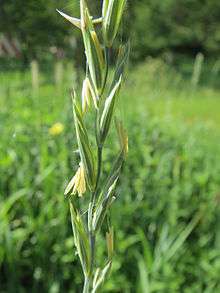Elymus trachycaulus
| Elymus trachycaulus | |
|---|---|
 | |
| Scientific classification | |
| Kingdom: | Plantae |
| (unranked): | Angiosperms |
| (unranked): | Monocots |
| (unranked): | Commelinids |
| Order: | Poales |
| Family: | Poaceae |
| Genus: | Elymus |
| Species: | E. trachycaulus |
| Binomial name | |
| Elymus trachycaulus (Link) Gould ex Shinners | |
Elymus trachycaulus is a species of wild rye known by the common name slender wheatgrass. It is native to much of North America, where it grows in widely varied habitats from northern Canada to Mexico.
It is variable in appearance, but generally bears a very narrow, linear inflorescence of spikelets appressed against the stem. There are three subspecies, two very widespread and one which is limited to Greenland.[1]
Habitat
Slender wheatgrass (Elymus trachycaulus) ideally grows in habitats that contain a balanced supply of moisture. The species can also tolerate higher salinity in the soil, making it easier to grow in more diverse habitats. [2] Studies in soil salinity tolerance have grown in interest due to changing environments and agricultural maintenance. In an experiment performed to assess the growth of slender wheatgrass and stressful salt levels, the results were “superior”. This cultivar can be established in a high-saline habitat over other grass cultivars. “Salt-tolerant, perennial forage crops capable of establishing on saline soils will provide protection against erosion, compete with weeds, utilize excess soil moisture, and in some situations provide forage for animals.” [3] Along with saline-stress tolerance, slender wheatgrass can also successfully grow in shallow or deep soils and in areas that aren’t limited by drift. They can inhabit an area and produce a stable living situation quickly. Generally this cultivar will persist between 5 and 10 years and produce a substantial seed count. [4]
References
- ↑ GRIN Profile: ssp. virescens
- ↑ Glover, D. E., et al. “Agronomic characteristics and nutritive value of 11 grasses grown with irrigation on a saline soil in southwestern Saskatchewan”. Canadian Journal of Plant Science. 84(2004): 1037-1050.
- ↑ Acharya, S. N., et al. “Salt stress tolerance in native Alberta populations of slender wheatgrass and alpine bluegrass”. Canadian Journal of Plant Science. 72(1992): 785-792.
- ↑ Perryman, B. L., Laycock, W. A., Koch, D. W. “Investigation of Herbaceous Species Adapted to Snowfence Areas”. Journal of Range Management. 53(2000): 371-375.